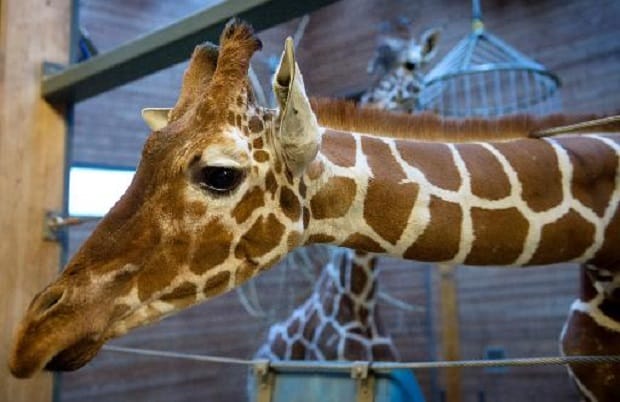The decision to allow an animal to be killed despite strong protests, has resulted in global anger and disgust

Justifiable outrage has followed the public killing of a healthy and peaceful baby giraffe by zoo staff in Denmark. Done in front of large groups of supporters of the baby giraffe named Marius, the audience included numerous children. A member of the zoo staff shot the animal with a rifle and its tender flesh was thrown to lions and other carnivores. The act smacks of being done in a hurry as worldwide protests as well as offers to take away the animal, were beginning to gain momentum. Social media has been saturated with condemnation, both before and after this senseless deed.
This barbaric act soured many pet lovers. The action was justified by Lesley Dickie, the Executive Director of the European Association of Zoos and Aquaria, on the grounds of limited space. The Copenhagen Zoo says it was preventing in-breeding. Was it? We have hopefully not heard the end of the story.
There are rumours that zoo staff, including Bengt Holst, Director of Research and Conservation, has received warnings and even death threats. What else could one expect? Before the public ‘euthanasia’ of the unfortunate animal, a petition by 27,000 people to save the harmless animal was ignored. After the outrageous act, another petition signed by 16,000 people have called for Bengt Holst to be sacked.
There had been offers to house the animal such as by Yorkshire Wildlife Park which has state-of-the art facilities for giraffes, but they received no response which raises the suspicion that the Copenhagen Zoo was determined to publicly kill the animal. If that is the case, were they trying to prove that they alone have the right to determine which animal lives or dies?
Fairfax Media reveals that some sixty-five animals were put down in Sydney’s Taronga Zoo last year. There was no public fanfare or provocative announcements.
In Australia we are taught by our education system to be kind to animals. Those who ill-treat animals have been taken to courts and perpetrators of inflicting cruelty have even been jailed. In one well-reported case, a former Premier of NSW Neville Wran, was taken to court because stray donkeys had wandered into a property owned by him. Those donkeys were in an emaciated condition, and Wran pointed out that he did not visit the property and knew nothing about the matter.
It has just been announced on February 13 that an individual who lured a baby great white shark into his boat and then beat it to death with a metal pole has been fined over $18,000 in New South Wales.
The barbaric and senseless deed of killing Marius must not go investigated. It seems to be based on the so-called ‘science of eugenics’ expounded by Francis Galton, incidentally a cousin of Charles Darwin. The idea of eugenics became the justification of racism just prior to World War II. Groups of Jewish people and gypsies were considered as intellectually inferior or as carrying physically undesirable traits were made to suffer under the Nazis and laws were enacted in several countries, including some states in the USA, to prohibit or restrict marriage with such groups known as ‘miscegenation’. A concept which found its way to the apartheid era of South Africa.
Charles Darwin’s ideas are quite the opposite to those of the eugenics, however much the eugenics camp tries to say otherwise. In Darwin’s The Descent of Man, he wrote: “With savages, the weak in body or mind are soon eliminated; and those that survive commonly exhibit a vigorous state of health. We civilised men… build asylums for the imbecile, the maimed, and the sick… our medical men exert their utmost skill to save the life of every one… The aid which we feel impelled to give to the helpless is mainly [a] result of… sympathy”.
Darwin knew the value of human sympathy. He had personally suffered when looking after his own children’s maladies. The National Disability Scheme, enacted in 2013 in Australia might have gained approval under true Darwinian principles, but it would not pass the scrutiny of the followers of eugenics.
Some of the introduced fauna in Australia have gone ‘feral’, which is an emotionally loaded word used to malign animals who have moved into the bush and become naturalised. Animals Australia writes: “The word ‘feral’ is incorrectly used… [it] accurately refers to native as well as non-native animals. However, it also has overtones of ‘savage’ and ‘brutal’. ‘Pest’, ‘noxious’ and ‘vermin’ are similarly emotionally loaded words which have no place in a sound and scientific discussion of these issues”.
The emotional use of words with regard to introduced species is found in the paper The Great Feral Cat Con Job: The Ungentle Art Of Scapegoating and Scaremongering by Frankie Seymour. The paper debunks myths like “Rabbits may have caused extinctions in arid Australia”. Public acts of barbarism such as that meted out to the innocent Marius, must not be allowed to be repeated.





